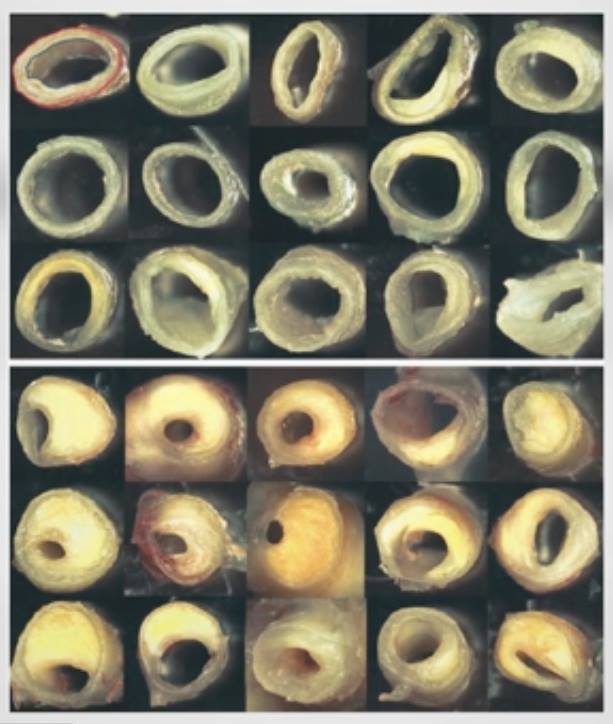Because atherosclerosis is the root cause of Coronary Artery Disease (CAD), a disease that develops progressively and silently inside our arteries for decades (yes, decades!), without any overt symptoms!
Why should we be worried?
- Extraordinarily High Incidence: Coronary Artery Disease is the most common form of heart disease, which is the #1 killer of men and women worldwide, in USA and in India. Incidence of heart disease among both Indians (in India) and Asian Indians in USA (born in India but living in USA) is extraordinarly high.
- SUDDEN DEATH: Coronary Artery Disease is a silent disease for so many decades! We experience no overt sypmtoms for years and years! And in this video, Dr Steven Lome (WFPB cardiologist) reminds us, "The first symptom in 1 out of 3 people with heart disease is SUDDEN DEATH!"
So let's spend some time studying the big picture of Atherosclerosis, the root cause of Coronary Artery Disease.
As shown in the Wikipedia pic below, atherosclerosis is the accumulation of plaque inside our arteries. Over time, our arteries become narrower. As plaque accumulates, it also hardens due to calcification.

Source: Atherosclerosis (Wikipedia)
A detailed but readable description of atherosclerosis is found here. Below, I summarize the story in simple language to help people visualize what atherosclerosis looks like and when it starts to develop. These days, in many of us, atherosclerosis starts developing in our childhood!
The words 'endothelium' and 'endothelial layer' come up often when WFPB doctors discuss heart disease. Let's see why.
What is endothelium? Our endothelium is a thin layer of cells that lines the inner walls of all of our arteries throughout our body! It's remarkable that this layer is only single-cell wide — a rather delicate structure that separates the arterial wall from the blood flowing through these arteries. I visualize the endothelial layer as an "internal skin" of sorts. And it's important to keep our endothelium in good health!
Injuries to endothelium: When our endothelium gets damaged, it gets inflamed and "pimples, lesions & scars" start forming. How does this happen? And at what age?
In the beginning stages of plaque development, atherosclerotic "lesions" form — these are like 'pimples' the endothelium (which is like an 'internal skin'). Later, as these lesions increase in size, "fatty streaks" develop. Eventually, these streaks become bigger and get calcified, which leads to hardening of plaque (which in turn hardens the arteries).
What do arteries with atherosclerosis look like? Please watch these videos to build a visual image of injured arterial walls:
- (Watch for 98 seconds at offset 1:22) Eat Your Way Out Of Heart Disease by Dr McDougall. He paints a nasty visual picture of "festering sores" inside our arteries. Just one of those thousands of sores has to "pop", leading to a heart attack.
- (Watch for 2:44 at offset 12:24) Eat Your Way Out Of Heart Disease by Dr Klaper. This video shows what atherosclerosis looks like. Pretty gross! Almost the same as the 3-min video by Dr Klaper beelow.
- (3 mins) Atherosclerosis by Dr Klaper. Worth watching to understand how we make our blood viscous and transluscent (with all the fats we consumed) within a few hours of a fatty meal! Note: The last 2-3 seconds of this video are gross — they show fatty plaque from arteries being removed. But this visual is exactly what may motivate some viewers to stop eating fatty foods to protect themselves from clogging their arteries!
- (3 mins) Arterial Acne by Dr Greger. Visual explanation of "zits in arteries" that lead to 'thrombosis' and heart attacks.
A grotesque Star Trek character? When I think of all these "pimples", lesions and "scars" developing on our endothelium (our "internal skin" that lines our arteries), I start imagining, "if these had developed on our external skin, thereby being visible to the naked eye, what would we have looked like?" Would we look like a grotesque-looking Star Trek character? Yeah, I think so!
Is atherosclerosis prevalent in all cultures worldwide? No!
- This video (6 mins, 2013) by Dr Greger explains Dr Burkitt's observations that heart disease was rare in rural Africa!
When does atherosclerosis start? I was surprised to learn that this process starts in early childhood for so many of us! In the Wikipedia pic on atherosclerosis, note the green column that says "from first decade", "from third decade", "from fourth decade". But why is it happening in childhood? For details, please see Heart Disease Starts in Childhood!
What is the relationship between atherosclerosis, heart attacks and sudden death? Please see What Causes Heart Attacks?
A comparison between clogged sewage pipes and clogged arteries was made by Marcin Kot in FaceBook group Chronic Health Plant Based Support and Coaching Group. The comparison is not 'scientific' but worth noting: clogged arteries do look like clogged sewage pipes!
Sewer pipes clogged with FAT (mostly Saturated Fat which becomes solid at lower temperatures) deposits are becoming a real problem! Some cities are issuing guidelines saying:
Curiously, something similar happens in our arteries! When cholesterol and fat (+some calcium added with time) infiltrates the injured endothelium and plaque builds-up, the result can be much more serious than a "mood killer"! It can be a real KILLER and often a silent killer, as Dr Steven Lome (WFPB cardiologist) reminds us in this video: "The first symptom in 1 out of 3 people with heart disease is SUDDEN DEATH!"

 Instagram
Instagram YouTube
YouTube

